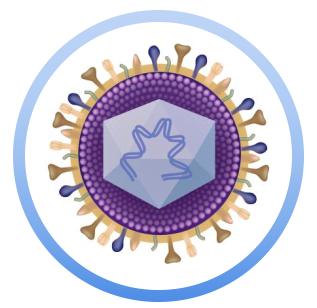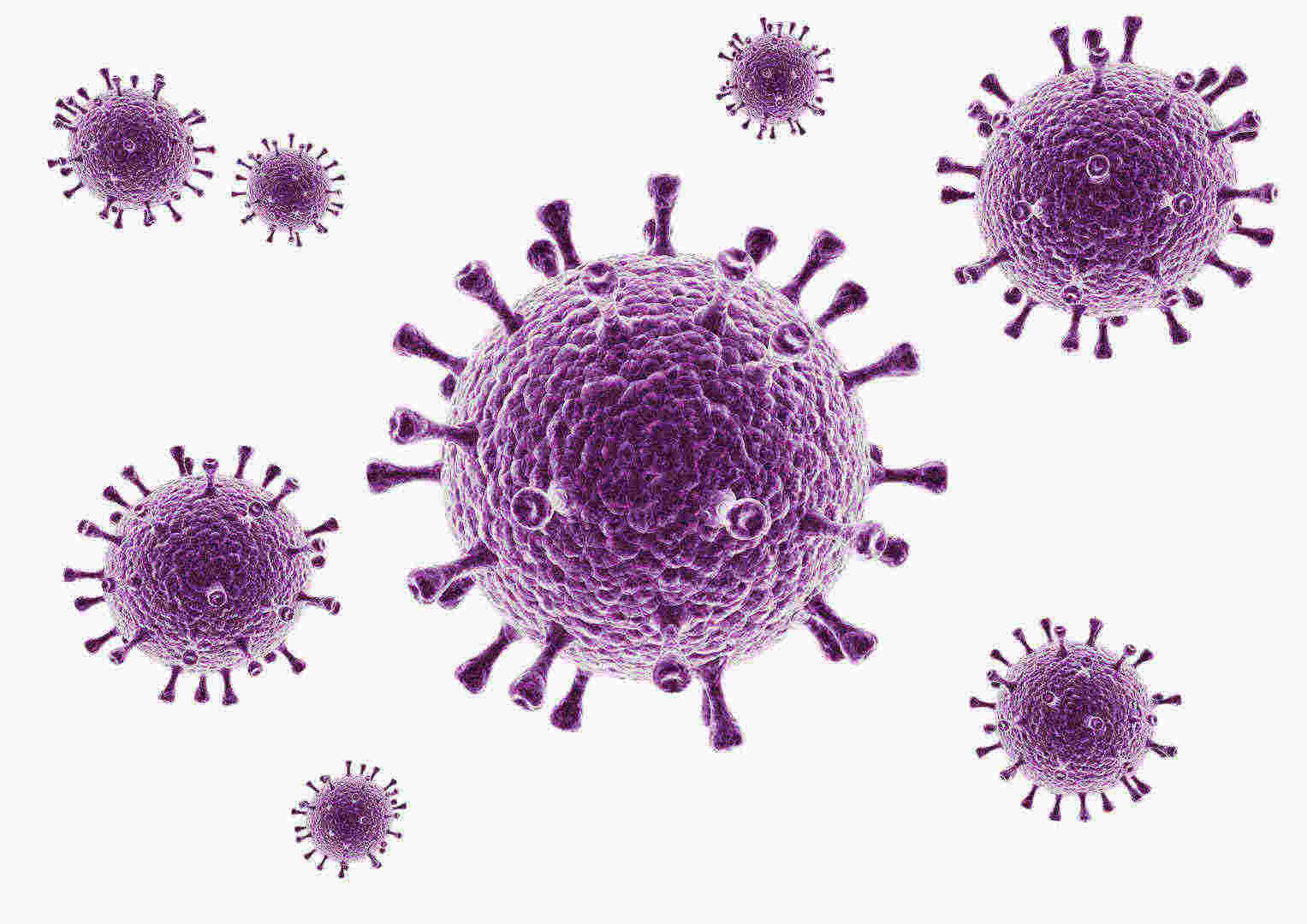
The subfamily Alphaherpesvirinae represents a group of fast-replicating, neurotropic viruses that are highly prevalent in the human population. Characterized by their ability to establish lifelong latent infections within the sensory neurons of their hosts, these viruses can reactivate periodically, causing a range of clinical manifestations from mild mucocutaneous lesions to severe, life-threatening diseases. The three most significant human pathogens in this subfamily are Herpes Simplex Virus 1 (HSV-1), Herpes Simplex Virus 2 (HSV-2), and Varicella-Zoster Virus (VZV).
Understanding the intricate molecular and cellular biology of these alpha-herpesviruses is paramount for the development of next-generation antiviral therapies and vaccines. For research institutions and pharmaceutical companies operating in the preclinical space, a profound grasp of their virology, replication cycle, and mechanisms of latency is critical. CD BioSciences is dedicated to advancing HHV research by providing cutting-edge tools, models, and specialized services tailored to the unique challenges of alpha-herpesvirus studies.
The Biology and Pathogenesis of Alpha-herpesviruses
Alpha-herpesviruses share a common architecture: a linear, double-stranded DNA genome encased within an icosahedral capsid, which is surrounded by a proteinaceous tegument and a lipid envelope studded with glycoproteins. These glycoproteins are crucial for host cell attachment and entry.
Their replication cycle is notably efficient and lytic. Following fusion with the host cell membrane, the viral capsid and tegument proteins are released into the cytoplasm. The capsid is then transported to the nucleus, where the viral DNA is released and circularizes. Gene expression occurs in a tightly regulated cascade—immediate-early (α), early (β), and late (γ) genes—orchestrating viral DNA replication, assembly of new virions, and modulation of the host's cellular environment to favor viral propagation.
However, the most defining characteristic of alpha-herpesviruses is their ability to establish latency. After an initial lytic infection at a peripheral site, such as the skin or mucosa, the virus particles enter the termini of sensory neurons. Through retrograde axonal transport, the viral genome reaches the neuronal cell body in the sensory ganglia (e.g., the trigeminal ganglia for oral HSV-1 or the dorsal root ganglia for VZV). Here, the viral DNA persists as a quiescent, extrachromosomal episome. During latency, transcription of lytic-cycle genes is silenced, and a distinct set of genes, known as Latency-Associated Transcripts (LATs), are expressed, which play a key role in maintaining the latent state and promoting neuronal survival.
Various stimuli, including stress, UV radiation, hormonal changes, or immunosuppression, can trigger reactivation. This leads to the re-initiation of the lytic gene expression cascade, production of new virions, and their anterograde transport back to the initial site of infection, causing recurrent clinical episodes.
Herpes Simplex Virus 1 & 2 (HSV-1, HSV-2)
HSV-1 and HSV-2 are among the most widespread human pathogens. While traditionally HSV-1 is associated with orofacial lesions (cold sores) and HSV-2 with genital herpes, the epidemiology is shifting, with an increasing number of genital herpes cases caused by HSV-1.
1. Virology and Transmission:
The genomes of HSV-1 and HSV-2 are approximately 152 kb and 155 kb, respectively, and they share significant genetic and antigenic similarity. Transmission occurs through direct contact with active lesions or asymptomatic viral shedding from mucosal surfaces.
2. Pathogenesis and Clinical Research:

Primary infection is often asymptomatic but can manifest as gingivostomatitis (HSV-1) or painful genital vesicles (HSV-2). Following the establishment of latency, reactivation leads to recurrent herpes. While typically causing localized disease, HSV can lead to more severe conditions.
- Herpes Keratitis: An infection of the cornea, primarily by HSV-1, which is a leading infectious cause of blindness in developed nations. Recurrent episodes can lead to corneal scarring and vision loss.
- Herpes Encephalitis (HSE): A rare but devastating infection of the central nervous system, predominantly caused by HSV-1, with high rates of mortality and neurological sequelae in survivors.
- Neonatal Herpes: A severe, disseminated infection that occurs when an infant is exposed to HSV (usually HSV-2) during childbirth.
Research into HSV pathogenesis is a key focus for drug development. Understanding the molecular triggers of reactivation is a major goal for preventing recurrent disease. The development of robust in vitro models, such as primary neuronal cultures and 3D organotypic tissue models, is essential for studying the HSV lifecycle in a biologically relevant context. CD BioSciences supports these efforts by providing characterized viral strains, cell lines, and advanced modeling services to facilitate preclinical investigation.
Varicella-Zoster Virus (VZV)
VZV is the causative agent of two distinct clinical syndromes: varicella (chickenpox) as the primary infection and herpes zoster (shingles) as the result of viral reactivation.
1. Virology and Transmission:
VZV has the smallest genome among the human alpha-herpesviruses, approximately 125 kb. It is highly contagious and transmitted primarily via respiratory droplets or direct contact with skin lesions.
2. Pathogenesis and Clinical Research:

Chickenpox is a common childhood illness characterized by a generalized vesicular rash. After the primary infection resolves, VZV establishes latency in the dorsal root, cranial nerve, and autonomic ganglia along the entire neuraxis.
With advancing age or a decline in cell-mediated immunity, VZV can reactivate, causing shingles. This condition is characterized by a unilateral, dermatomal vesicular rash, which is often preceded and accompanied by severe neuropathic pain. The most common and debilitating complication of shingles is postherpetic neuralgia (PHN), a chronic pain syndrome that can persist for months or years after the rash has healed.
Unlike HSV, VZV is less prone to asymptomatic shedding, and viremia is a hallmark of primary infection. In immunocompromised individuals, both primary varicella and zoster can be severe, leading to disseminated infection involving the lungs, liver, and central nervous system.
Research into VZV is complicated by its highly species-specific nature, as it only efficiently infects human cells. This has spurred the development of specialized animal models, such as xenografts of human dorsal root ganglia in immunodeficient mice, to study latency and reactivation in vivo. These models are crucial for testing novel antiviral compounds and vaccine candidates.
Advancing Preclinical Research and Development
The current standard of care for alpha-herpesvirus infections relies on nucleoside analogues like acyclovir and its derivatives (valacyclovir, famciclovir). These drugs target the viral DNA polymerase and are effective at controlling lytic replication but cannot eradicate the latent reservoir, necessitating long-term suppressive therapy for some patients and doing little to prevent transmission. Furthermore, the emergence of drug-resistant strains, particularly in immunocompromised patients, presents a significant clinical challenge.
This unmet medical need drives the R&D landscape toward new therapeutic strategies. CD BioSciences is committed to partnering with researchers to explore these innovative avenues.
Novel Antiviral Targets:
Preclinical research is actively investigating new viral and host targets to overcome the limitations of current therapies. Key areas of focus include:
Helicase-Primase Inhibitors
Compounds like pritelivir and amenamevir inhibit the viral helicase-primase complex, which is essential for unwinding viral DNA during replication. This different mechanism of action makes them effective against acyclovir-resistant strains.
Terminase Complex Inhibitors
This complex is responsible for packaging the viral genome into newly formed capsids, making it an attractive target for inhibiting the production of infectious virions.
Latency-Disrupting Agents
"Shock and kill" strategies aim to reactivate the virus from latency with specific agents and then eliminate the reactivated cells with a conventional antiviral, though this approach faces significant safety hurdles.
Inhibitors of Latency Establishment
A more sought-after goal is to develop drugs that prevent the virus from establishing latency in the first place.
Therapeutic and Prophylactic Vaccines:
While a highly effective live-attenuated vaccine exists for VZV (preventing both chickenpox and reducing the incidence of shingles), there is currently no approved vaccine for HSV-1 or HSV-2. The development of an effective HSV vaccine is a major public health priority. The field is exploring various platforms:
Subunit Vaccines
These are based on specific viral glycoproteins (e.g., gD, gB) that are crucial for viral entry and are major targets for neutralizing antibodies.
mRNA Vaccines
Leveraging the success seen with other viral pathogens, mRNA platforms offer a rapid and flexible approach to expressing viral antigens and eliciting robust immune responses.
Vectored Vaccines
Using replication-deficient viral vectors to deliver HSV antigens.
Therapeutic Vaccines
Designed not to prevent infection, but to boost the immune response in already infected individuals to reduce the frequency and severity of recurrent episodes.
At CD BioSciences, we provide comprehensive support for these research endeavors. Our portfolio includes the generation of custom viral constructs, high-throughput screening assays for antiviral compound discovery, and the development of assays to evaluate immune responses to vaccine candidates. We offer a suite of solutions to help our clients navigate the complexities of alpha-herpesvirus research, from target identification and validation to lead optimization and preclinical testing. Together, we can accelerate the journey towards novel interventions that can control and ultimately conquer the diseases caused by this pervasive viral family.
References
- Whitley, R. J., & Baines, J. (2018). The Molecular and Cellular Biology of the Herpesviruses: A Look at the Future. Journal of Infectious Diseases, 218(suppl_2), S51–S53.
- Griffin, M. P., & Damania, B. (2022). Thirty years of viral interference: The K-bZIP protein of KSHV. PLOS Pathogens, 18(9), e1010777.
- DiMaio, F., & Kinch, L. N. (2020). The power of AlphaFold. Protein Science, 29(10), 2059-2061.
- Arvin, A. M., Gilden, D., & Kinchington, P. R. (2021). Varicella-zoster virus biology and the development of a safe and effective zoster vaccine. The Journal of Clinical Investigation, 131(18), e149457.
- Johnston, C., & Koelle, D. M. (2021). Herpes Simplex Virus: Global acquisition and transmission. The Journal of Infectious Diseases, 223(Supplement_1), S1–S3.
- Looker, K. J., Magaret, A. S., May, M. T., Turner, K. M. E., Vickerman, P., Gottlieb, S. L., & Newman, L. M. (2015). Global and regional estimates of prevalent and incident herpes simplex virus type 1 infections in 2012. PLOS ONE, 10(10), e0140765.
- Bernstein, D. I., & Gominak, S. (2022). The Development of Herpes Simplex Virus Vaccines. Viruses, 14(3), 543.
- Kennedy, P. G. E., & Gershon, A. A. (2018). Clinical Features of Varicella-Zoster Virus Infection. Viruses, 10(11), 609.